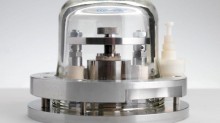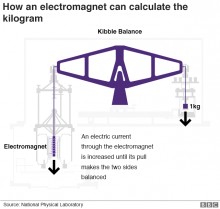How wrong is Le Grand K?
The fluctuation is about 50 parts in a billion, less than the weight of a single eyelash. But although it is tiny, the change can have important consequences. Coming in is an electrical measurement which Dr Stuart Davidson, head of mass metrology at NPL, says is more stable, more accurate and more egalitarian.
"We know from comparing the kilogram in Paris with all the copies of the kilogram that are all around the world that there are discrepancies between them and Le Grand K itself," he said.
"This is not acceptable from a scientific point of view. So even though Le Grand K is fit for purpose at the moment, it won't be in 100 years' time."
How does the new system work?
Electromagnets generate a force. Scrap-yards use them on cranes to lift and move large metal objects, such as old cars. The pull of the electromagnet, the force it exerts, is directly related to the amount of electrical current going through its coils. There is, therefore, a direct relationship between electricity and weight.
So, in principle, scientists can define a kilogram, or any other weight, in terms of the amount of electricity needed to counteract the weight (gravitational force acting on a mass).
Post completo en BBC News
















